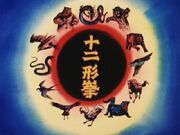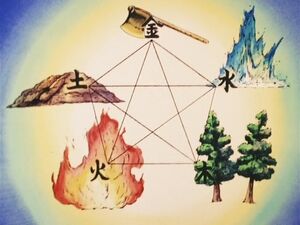Chojin Kung Fu (超人拳法 Chōjin Kenpō)
About
Taught to Victory Ramenman by Chen Zong-Ming, it contains the Chōjin Hyakuni Gei (超人一〇二芸, 102 Chōjin Attacks) techniques that Ramenman fought with. For generations, each successor devised a new technique and added it to the Gokui Sho. Because Ramenman had already contributed the Camel Clutch, they are technically now the Chōjin Hyakusan Gei (超人一〇三芸, 103 Chōjin Attacks). Furthermore, each techniques is numbered, although only the Zukotsu Kirimomi Kyaku (#1), Hyakusen Haykushou Kyaku (#8), Meidatsu Houkai Ken (#72), and the Rekka Taiyou Kyaku (#82) were ever established.
The majority of the techniques are kicks, but there are Kenpo attacks and spells as well. Additionally, in earlier chapters Ramenman is shown to be able to use the Gokui Sho as armor (by wrapping it around his body), as well as transforming it into a pair of nunchaku.
Choujin Hyakuni Gei
Chōjin Hyakuni Gei (超人一〇二芸, 102 Chōjin Attacks) Because Ramenman had already contributed the Camel Clutch, they are technically now the Chōjin Hyakusan Gei (超人一〇三芸, 103 Chōjin Attacks). Furthermore, each techniques is numbered, although only the Zukotsu Kirimomi Kyaku (#1), Hyakusen Haykushou Kyaku (#8), Meidatsu Houkai Ken (#72), and the Rekka Taiyou Kyaku (#82) were ever established.
The majority of the techniques are kicks, but there are Kenpo attacks and spells as well.
Kicking Techniques
- Dai Sharin Geri (大車輪蹴り, Giant Swing Kick)
- Hien Senpū Kyaku (飛燕旋風脚, Swallow Whirlwind Kick)
- Rekka Taiyō Kyaku (烈火太陽脚, Blaring Solar Kick)
- Rakuyō Kurenai Kyaku (落陽紅脚, Crimson Sunset Kick)
- Zukotsu Kirimomi Kyaku (頭骨錐揉脚, Spinning Skull Kick)
- Hyakusen Hyakushō Kyaku (百戦百勝脚, Ever Accurate Kick)
- Kōhō Fūsha (後方風車, Rear Windmill)
- Haimen Fūsha (背面風車, Reverse Windmill)
- Haimen Kobi Kyaku (背面虎尾脚, Reverse Tiger Tail Kick)
- Kaiten Ryūbi Kyaku (回転龍尾脚, Spinning Dragon Tail Kick)
- Hishō Sayū Kyaku (飛翔左右脚, Soaring Left and Right Kick)
- Shintotsu Kugisaki Kyaku (心突釘裂脚, Piercing Needle Nail Splitting Kick)
- Kinkei Tobihiza Kyaku (金鶏飛び膝脚, Golden Chicken Flying Knee Kick)
- Haigan Sayū Fūsui (背眼左右封捶, Reverse Left and Right Eye Seal)
- Sensui Tobi'uo Kyaku (潜水飛魚脚, Diving Flying Fish Kick)
Fist Techniques
- Hyappo Shin Ken (百歩神拳, Hundred Feet God Fist)
- Meidatsu Hōkai Ken (命奪崩壊拳, Life Stealing Crumbling Fist)
- Meidatsu Shiō Ken (刺葉, Life Stealing Leaf Piercing Fist)
- Daketsu Santen Kuzushi (打穴三点崩し, Three Weak Points Destroyer)
- Camel Clutch (機矢滅留・苦落血, Kyameru Kuratchi)
- Senju Kujaku Ken (千手孔雀拳, Thousand Hand Peacock Fist)
- Suimen Ryōdan Ken (水面両断拳, Water's Surface Splitting Fist)
- Hurricane (破裏拳, Harikeen)
- Sōryū Dai Hachiguruma (双龍大八車, Double Dragon Wagon)
- Mukade Taihō Ken (百足大砲拳, Centipede Cannon Fist)
Spells
- Hyappo Shin Gan (百歩神眼, Hundred Feet God Eye)
- Kashi no Gei (仮死の芸, Fake Death Technique)
- Jinseki Fūsa (人石封鎖, Human Stone Encasement)
- Sekihei Hachijin (石兵八陣, Eight Stone Soldiers Camp)
- Raien Buttai Idō Jutsu (雷燕物体移動術, Swallow Migration Technique)
Top Techniques
The highest level techniques of the Chōjin Hyakuni Gei. Because it is believed that whoever learns them is capable of becoming a god or devil, only those with a reasonable mind were allowed to study them. However, after the Chikinmon San Akunin Arc the studying of them became prohibited, with the sole exception of Ramenman.
- Gojū Hyappo Ken (五獣百歩拳, Five Hundred Feet Beasts Fist)
- Mōko Hyappo Ken (猛虎百歩拳, Hundred Feet Fierce Tiger Fist)
- Sōsei Mōko Ken (双星猛虎拳, Double Star Fierce Tiger Fist)
- Tenkū Shōko Kyaku (天空翔虎脚, Midair Flying Tiger Kick)
- Kyōryoku Mōko Ken (協力猛虎拳, Collaborated Fierce Tiger Fist)
- Byakko Benidaka Ken (白虎紅鷹拳, Hundred Tiger Crimson Hawk Fist)
- Kinjishi Hyappo Ken (金獅子百歩拳, Hundred Fist Golden Lion Fist)
- Koutetsu Mōko Ken (鋼鉄猛虎拳, Steel Fierce Tiger Fist)
- Kyōko Hyappo Ken (凶虎百歩拳, Hundred Feet Evil Tiger Fist)
- Bukiman Seizō Jutsu (武器男製造術, Bukimen Creation Technique)
- Dantōgame (断頭瓶, Guillotine Pot)
- Gotai Sanpo Jutsu (五体散歩術, Five Walking Bodies Technique)
- Fūin Jūji Ken (封印十字剣, Sealed Cross Blade)
Five Element forms
Chojin Kung-Fu uses the five classical Chinese elements to metaphorically represent five different states of combat. Also called the "Five Fists" or "Five Phases," the Five Elements are related to Taoist cosmology although the names do not literally correspond to the cosmological terms.
Chojin Kung-Fu practitioners use the five elements as an interpretative framework for reacting and responding to attacks. This follows the five element theory, a general combat formula which assumes at least three outcomes of a fight; the constructive, the neutral, and the destructive. Chojin Kung-Fu students train to react to and execute specific techniques in such a way that a desirable cycle will form based on the constructive, neutral and destructive interactions of five element theory. Where to aim, where to hit and with what technique—and how those motions should work defensively—is determined by what point of which cycle they see themselves in.
Each of the elements has variant applications that allow it to be used to defend against all of the elements (including itself), so any set sequences are entirely arbitrary, though the destructive cycle is often taught to beginners as it is easier to visualize and consists of easier applications. Some schools will teach the five elements before the twelve animals because they are easier and shorter to learn.
| Chinese | Pinyin | |||
|---|---|---|---|---|
| Chopping | 劈 | Pī | Metal | Like an axe chopping up and over. |
| Drilling | 鑽 | Zuān | Water | Drilling forward horizontally like a geyser. |
| Crushing | 崩 | Bēng | Wood | Arrows constantly exploding forward. |
| Exploding | 炮 | Pào | Fire | Exploding outward like a cannon while blocking. |
| Crossing | 橫 | Héng | Earth | Crossing across the line of attack while turning over. |
Animal forms

Chojin Kung-Fu is based on twelve distinct animal forms (形; pinyin: xíng). Present in all regional and family styles, these emulate the techniques and tactics of the corresponding animal rather than just their physical movements. Many schools of Chojin Kung-Fu have only small number of movements for each animal, though some teach extended sequences of movements. Once the individual animal forms are taught, a student is often taught an animal linking form (shi'er xing lianhuan) which connects all the taught animals together in a sequence. Some styles have longer, or multiple forms for individual animals, such Eight Tiger Forms Huxing bashi.
| Chinese | Pinyin | Onyomi | ||
|---|---|---|---|---|
| Dragon | 龍 | Lóng | Ryū | The only "mythical" animal taught. In some lineages it is practiced separately from tiger because they are said to clash. |
| Tiger | 虎 | Hǔ | Ko | Features lunging with open-handed clawing attacks mimicking the pounce of a tiger |
| Monkey | 猴 | Hóu | Kō | Performed with light, empty movement, simple striking combined with parrying and deception of distance. |
| Horse | 馬 | Mǎ | Ba | Combination of Metal and a hand movement that mimics the action of a rearing a horse. Performed with tension, however. |
| Alligator | 鼉 | Tuó | Da | The animal it is meant to represent is the Yangtze River alligator. Sometimes referred to as a water-skimming insect, or water lizard. The movements of a yangtze river alligator have been compared to those of a pig crossed with a dragon. |
| Chicken | 鷄 | Jī | Kei | Mimics the pecking movement of a chicken. This form also mimics the quick and aggressive combat style of the rooster. |
| Sparrowhawk | 鷂 | Yào | Yō | This can mean 'Sparrowhawk,' though the more common word for "Sparrowhawk" used to be Zhān (鸇), which has fallen from use over the years. The Chinese word for "Goshawk" covers both the Goshawk and the Sparrowhawk. Note - in some lineages this animal is translated to mean the Grouse or small pheasant, as well as the phoenix. |
| Swallow | 燕 | Yàn | En | Follows the swift and random movements of the swallow by rotating position and circling the enemy with strong but quick foot movement. May refer to the Purple Swamphen (Rallidae) Coot. |
| Snake | 蛇 | Shé | Ja | Includes both Constrictor and Viper styles. |
| Paradise Flycatcher | 𩿡 | Tái | Tai | This is a flycatcher native to Asia. Due to the rarity of this character it may be translated as ostrich, dove, hawk or even phoenix. The Chinese for this animal is not in the earlier versions of the Unicode standard so not all computers are capable of displaying it. For further information, check the Unihan database for complete data on this character. |
| Eagle | 鷹 | Yīng | Yō | In Kung-Fu, "the Bear and Eagle combine," meaning that the Bear and Eagle techniques are often used in conjunction with each other. There is a bird called the "Bear Eagle," which covers the characteristics of both forms. |
| Bear | 熊 | Xióng | Yū |

